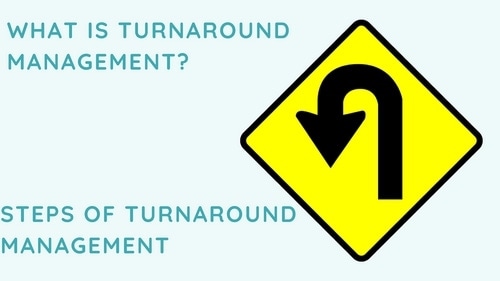The process of Turnaround Management can be defined as the process of reviving a company that is struggling from the financial problems to keep up with competition in the market and there comes a time when the management of the company needs to put the process and strategic approach of Turnaround Management plan in place.
The main and crucial key elements of the Turnaround Management include analyzing, planning, and then implementing the plan to save the company from all the bottlenecks and obstacles that it is facing. However, the realities of turnaround management are that it is quite slow, complex, and difficult process in nature and its overall implementation.
Turnaround Management is all about the restricting and renewal of the business. Often, this strategy is employed when the business is under financial stress. However, it is not necessary to wait till the situation becomes too complicated to commence the turnaround Management strategy.
Table of Contents
5 Steps of Turnaround Management :
Step 1 – Define & Analyse
During the first and foremost stage, the definition of performance problems within the business are clearly defined and outlined. It is particularly important during this step that any areas of financial stress within the business are identified through the intricate analysis and in-depth study. The main aim and objective of this are to stop any further decline in the business while continuing to trade and avoid insolvency of the business.
Step 2 – Scope & Strategy
Once the business is stabilized, now is the time to start with the strategic planning process. The first part of this is to scope the strengths, weaknesses, opportunities, and threats of the business.
It is important during this stage to not only look internally (strengths and weaknesses) but to strategically analyze the external environment (opportunities and threats) in a dedicated manner. Through the process of the SWOT analysis, long-term vision, mission, core values and objectives for the business can be defined in a better way. Knowing where the business is heading allows the development of a strategic plan and its overall implementation in an effective fashion.
Step 3 – Link & Action
Next step in the line is to take the strategic plan and develop into an action plan. This is a list of actions and tasks that are to be completed within the stipulated time frames that must be undertaken to attain the business goals and objectives. The tasks are divided on the basis of the daily, weekly, and monthly activities that are to be completed and with this strategic planning process, each one will be contributing to the overall mission of the organization.
Step 4 – Implement
This step is not just about implementing the action plan, but also ensuring all the required coaching and support of all staff and employees of the organization. Without this critical step, all the planning can go to waste and down in dumps. It is quite crucial that employees are aligned with the overall vision and mission of the business. This is achieved through clear communication, dedicated consultation, and coaching on a regular basis to all the employees.
Step 5 – Review
With all the planning and implementation in place, the next step of the Turnaround Management demands to conduct regular reviews. This ensures not only that continual improvement is achieved but also helps to identify any corrective actions that may be needed within the overall process and operations of the business.
The process of Turnaround Management is quite similar to the strategic planning process; however, the first step in identifying areas of stress in the business is very critical to figure out. For any business where this stress is already occurring, applying the turnaround process, in consultation with a Turnaround Management experts, will not only ensure the business turnaround but also the opportunity to improve and grow in the future with the learning curve and streak of success.
The 3 Stages of Turnaround Management :
1) Assess Viability
The first stage comprises a high level and detailed investigation of the business and its problematic situation and can take around 2-4 weeks of time.
The investigation acquires a wide range of information to be figured out that includes:
- Current and historical financials (P&L, balance sheet, cash flow and verification these accounting and costing systems, if they are reliable in nature or not)
- List of the Stakeholders and debtors
- Management capability
- Cause of situation or the problem
- Potential solutions to solve the problem
- Assess if business issues are controllable or not
- Assess if the ongoing business is viable or not
- Develop a SWOT analysis to provide clarity on all the given options.
2) Stabilize and Develop Strategy
Once the issues and priorities have been identified and agreed to by all the key members of the management and the company, stage 2 involves on focusing on the aspect of stabilizing the business and planning the recovery strategy from all the issues and problems. The timeframe can vary widely depending on the business situation, problems and their nature of complexity and can take from 4 weeks to 3 months time to complete the same. The turnaround strategy consists of the following factors, and may occur concurrently and in any given order depending on the merit of the case:
- Crisis stabilization that encompasses taking control, management of cash, short-term financing options, first step cost reduction.
- New team for leadership – owing to inadequate skills of the current team, instability in management, need for fresh and creative ideas.
- Stakeholder focus – advising and engaging stakeholders dependent on the outcome and includes financiers, creditors, employees, customers, industry associations and even government officers as well for various reasons. The benefit of this aspect is often underestimated and often provides the greatest source of solutions and support to solve the problems of the business and an effective Turnaround Management.
- Strategic focus – redefining the core business, restructuring, M&A, divestment, values, and fundamentals.
- Organizational change – engaging the key staff, improving the levels of communication, and improving the morale of the employees.
- Process improvements – operational improvements that provide low hanging fruit, and focus on key issues that require instant attention.
- Financial restructuring – implementing tighter control and monitoring of cash, equity injection, asset reduction or selling under-utilized assets to generate cash or use as security for short-term funding that will be quite beneficial for the organization.
3) Implementation and Monitoring
Once Stage 2 is underway and under process, the focus will be the detailed implementation and monitoring of the finalized strategy. This may include setting up an advisory board to assist the owners, directors, or board to maintain its focus on the implementation of the strategy. The business may bring on board a Chief Restructuring Officer whose main and principle role is to implement the Turnaround Management strategy
Signs of a Troubled Business that requires Turnaround Management:
1) Market conditions and low market share
Fluctuations in the marketplace and its dynamic nature have evaded a company, leaving it with low sales and losing market share as compared to the competitors. For some companies, there is a lack of technological advancement as the current ones have become quite outdated. In other companies, the problem lies in the areas of sales and marketing; their products or services slide into the mundane rut as the company has not kept the thorough pace with the needs of the marketplace.
2) Lack of operating controls
Managing a company without adequate reporting mechanisms can be very problematic. If management is making decisions on the traditional and incorrect information, the company can easily go in the wrong direction of the decision making and strategy processes.
3) Over-diversification
In a contemporary situation of the market and the overall industry, many businesses feel the pressure to diversify in order to lessen the risk of finances and other factors. However, too much of diversification may cause them to spread themselves too thin making them exposed to the competition.
4) Explosive growth
Companies are sometimes very much desirous to add value by engineering a growth spurt. And many a time, the company cannot expand its way out of trouble. Growth often carries a very high price tag with it and leveraging a company to such a degree means that management must operate with little or no margins.
5) Family vs. business matters
It has been observed that there is rivalry among many privately held companies and family runs businesses. Deciding which relative or which of their offspring should run the business after retirement or death for the main head of the business can be one of the most difficult challenges for a privately held business. If the decision is based on emotions instead of good business judgment, the company can be in troubled waters very soon.
6) Operating without a business plan and strategy
There are numerous progressive companies operate without a business plan in the market. Their plan may change overnight because it is based on their own instinct or feel for the market.
7) Ineffective management style
The CEO or the founder of a company may be unable to give proper guidance and authority and the rest of the key management staff is without the solid experience in the industry and the feeling of ownership.
8) Poor lender relationships
Some companies develop an adversary relationship with their financial lending institutions that lead to financial and cash flow issues within the company.
Liked this post? Check out the complete series on Management

